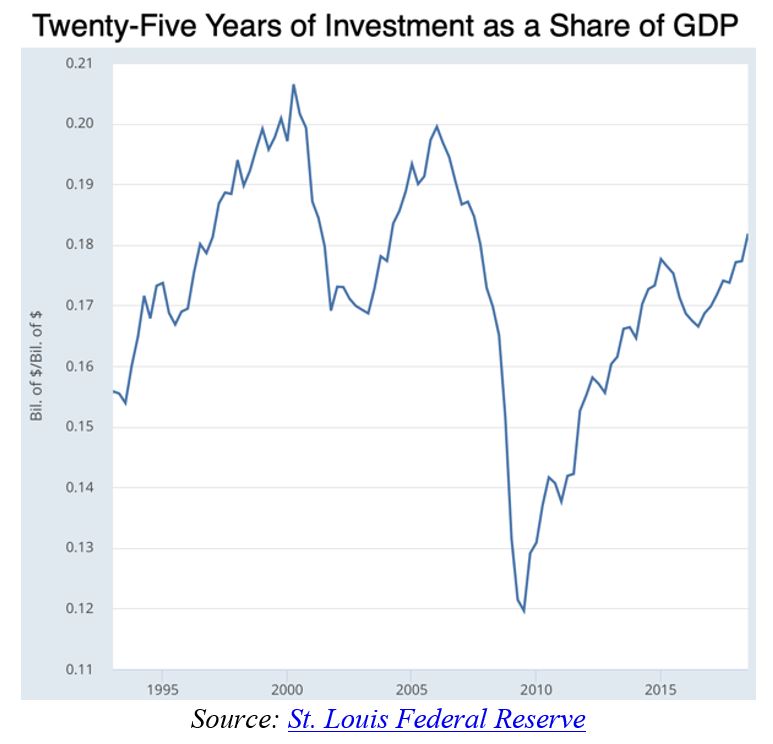
Last December, Republicans relied on the support of conservative economists who predicted that the party’s corporate tax cuts would boost productivity and investment in the United States substantially. The forecasts were wrong, and the silence of those who made them suggests that they knew it all along.
It has now been one year since US President Donald Trump and his fellow Republicans rammed their massive corporate tax cut through Congress. At the time, critics of the “Tax Cuts and Jobs Act” described it as a cynical handout for wealthy shareholders. But a substantial number of economists came out in support of it.
For example, one prominent group, most of whom served in previous Republican administrations, predicted in The Wall Street Journal that the tax cuts would boost long-run GDP by 3-4%, with an “associated increase” of about 0.4% “in the annual rate of GDP growth” over the next decade. And in an open letter to Congress, a coterie of over 100 economists asserted that “the macroeconomic feedback generated by the [tax cuts]” would be “more than enough to compensate for the static revenue loss,” implying that the bill would be deficit-neutral over time.
Likewise, in a commentary for Project Syndicate, Robert J. Barro of Harvard University argued that the tax cuts would increase long-run real (inflation-adjusted) per capita GDP by an improbable 7%. And Michael J. Boskin of the Hoover Institution endorsed his analysis in a follow-up commentary.
Finally, Kevin Hassett, Chairman of the White House Council of Economic Advisers, and Greg Mankiw of Harvard University claimed that the productivity gains stemming from the tax package would primarily boost wages, rather than profits, because foreign savers would pour investment into the US.
To be sure, these were primarily long-run predictions. But proponents of the bill nonetheless claimed that we would see enough additional investment to boost growth by 0.4% per year. That implies an increase in annual investment of roughly $800 billion – that is, an increase from 17.5% to about 21.5% of GDP. We cannot know how much the US economy would grow in the absence of the tax cuts. But, as the chart below shows, investment has not jumped to that level, nor does it show signs of doing so anytime soon.

This comes as no surprise. Back when all the aforementioned economists were issuing their sanguine predictions about the tax package’s likely effects, neutral scorekeepers such as the Tax Policy Center were painting a more realistic picture. And unlike most proponents of the cuts, the Tax Policy Center’s raison d’être is not to please donors or support a particular political party, but rather to make the best forecasts that it can.
The deep disagreement last year over the tax bill’s potential effects anguished Binyamin Applebaum of The New York Times. “What does it mean to produce the signatures of 100 economists in favor of a given proposition when another 100 will sign their names to the opposite statement?” Applebaum asked on Twitter at the time. “How does Harvard, for example, justify granting tenure to people who purport to work in the same discipline and publicly condemn each other as charlatans? How are ordinary people, let alone members of Congress, supposed to figure out which tenured professors are the serious economists?”
We can now answer that last question. Scholarship is about the pursuit of truth. When scholars find that they have gotten something wrong, they ask themselves why, in order to improve their methodology and possibly get it less wrong in the future. The economists who predicted that tax cuts would spur a rapid increase in investment and sustained growth have now been proven wrong. If they were serious academics committed to their discipline, they would take this as a sign that they have something to learn. Sadly, they have not. They have remained silent, which suggests that they are not surprised to see investment fall far short of what they promised.
But why should they be surprised? After all, it would be specious to assume, as their models do, that investment can rapidly rise (or fall) as foreign investors flood into (or flee) the US. Individuals and firms do not suddenly ratchet up their savings just because the after-tax profit rate has increased. While a higher profit rate does make saving more profitable, it also increases the income from one’s past savings, thus reducing the need to save. Generally speaking, the two balance out.
All of those who published op-eds and released studies supporting the corporate tax cuts last year knew (or should have known) this to begin with. That is why they have not bothered to investigate their flawed forecasts to determine what they may have missed. It is as if they knew all along that their predictions were wrong.1
For reporters still wondering which economists to listen to, the answer should now be clear. If there is one message to take from the past year, it is: “Fool me once, shame on you; fool me twice, shame on me.”



Expositores: Oscar Vidarte (PUCP) Fernando González Vigil (Universidad del Pacífico) Inscripciones aquí. Leer más
Una retrospectiva para entender los próximos cuatro años. Leer más
En la conferencia se hará una presentación de los temas más relevantes del proceso de negociación se llevó a cabo desde el 2012, así como del acuerdo de paz firmado entre el Gobierno colombiano y la guerrilla de las FARC a finales del 2016. Se analizarán los desafíos y las... Leer más
El Observatorio de las Relaciones Peruano-Norteamericanas (ORPN) de la Universidad del Pacífico es un programa encargado de analizar y difundir información relevante sobre la situación política, económica y social de Estados Unidos y analizar, desde una perspectiva multidisciplinaria, su efecto en las relaciones bilaterales con el Perú.
© 2025 Universidad del Pacífico - Departamento Académico de Humanidades. Todos los derechos reservados.

